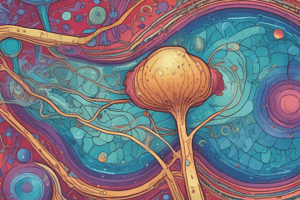Podcast
Questions and Answers
What is the primary reason that fruit pieces shrink when placed in a highly concentrated sugar solution?
What is the primary reason that fruit pieces shrink when placed in a highly concentrated sugar solution?
- The fruit cells absorb the sugar, leading to an increase in their internal pressure and subsequent shrinkage.
- The high sugar concentration damages the cell walls, causing them to collapse.
- Water moves out of the fruit cells into the sugar solution due to exosmosis. (correct)
- The sugar molecules actively transport water out of the fruit cells.
Plasmolysis, the contraction of cytoplasm in a cell, occurs when a cell is placed in which type of solution?
Plasmolysis, the contraction of cytoplasm in a cell, occurs when a cell is placed in which type of solution?
- Buffered solution, which maintains a stable pH.
- Hypotonic solution, where the solute concentration is lower outside the cell.
- Isotonic solution, where the solute concentration is equal inside and outside the cell.
- Hypertonic solution, where the solute concentration is higher outside the cell. (correct)
Which of the following statements accurately describes the unique characteristics of mitochondria and plastids that differentiate them from other cell organelles?
Which of the following statements accurately describes the unique characteristics of mitochondria and plastids that differentiate them from other cell organelles?
- They are the only organelles visible under a standard light microscope.
- They possess the ability to replicate independently due to the presence of their own DNA and ribosomes. (correct)
- They are responsible for the cell's waste disposal and recycling processes.
- They are incapable of synthesizing their own proteins.
What is the primary function of cristae, the folded structures found within the inner membrane of mitochondria?
What is the primary function of cristae, the folded structures found within the inner membrane of mitochondria?
What type of plastids are primarily involved in the synthesis and storage of starch, oils, and proteins?
What type of plastids are primarily involved in the synthesis and storage of starch, oils, and proteins?
Which of the following best describes the relationship between good behavior and opportunities, based on the principles provided?
Which of the following best describes the relationship between good behavior and opportunities, based on the principles provided?
A scientist observes a cell under a microscope. Which of the following characteristics would definitively classify it as a eukaryotic cell?
A scientist observes a cell under a microscope. Which of the following characteristics would definitively classify it as a eukaryotic cell?
A cell is placed in a solution, and over time, it shrinks. What type of solution is the cell most likely in?
A cell is placed in a solution, and over time, it shrinks. What type of solution is the cell most likely in?
Which cellular process is characterized by the movement of molecules from an area of high concentration to an area of low concentration without the use of cellular energy?
Which cellular process is characterized by the movement of molecules from an area of high concentration to an area of low concentration without the use of cellular energy?
If a plant cell is placed in a hypotonic solution, what is most likely to occur?
If a plant cell is placed in a hypotonic solution, what is most likely to occur?
Exocytosis is a process by which cells:
Exocytosis is a process by which cells:
In osmosis, what determines the direction of water movement across a selectively permeable membrane?
In osmosis, what determines the direction of water movement across a selectively permeable membrane?
Which of the following statements accurately describes the movement of solute molecules during osmosis?
Which of the following statements accurately describes the movement of solute molecules during osmosis?
Flashcards
Plasmolysis
Plasmolysis
The process where water exits a cell into a hypertonic solution, causing cytoplasm to contract.
Cell Organelles
Cell Organelles
Specialized subunits within cells that perform specific functions; essentially, the cell's organs.
Plastids
Plastids
Organelles in plant cells responsible for color and photosynthesis.
Leucoplasts
Leucoplasts
Signup and view all the flashcards
Cristae
Cristae
Signup and view all the flashcards
Two Main Cell Types
Two Main Cell Types
Signup and view all the flashcards
Eukaryotic cell subtypes
Eukaryotic cell subtypes
Signup and view all the flashcards
Exocytosis
Exocytosis
Signup and view all the flashcards
Diffusion
Diffusion
Signup and view all the flashcards
Osmosis
Osmosis
Signup and view all the flashcards
Isotonic Solution
Isotonic Solution
Signup and view all the flashcards
Hypotonic Solution
Hypotonic Solution
Signup and view all the flashcards
Hypertonic Solution
Hypertonic Solution
Signup and view all the flashcards
Study Notes
- Learning is the only way to improve your life.
- Kindness results from true knowledge.
- Learning begins with respect.
- Opportunities increase with good behavior and decrease with bad behavior.
- Cells vary in size and structure depending on their function and compose every organ in the body.
- Cells are of two main types: prokaryotic and eukaryotic.
- Eukaryotic cells have two subtypes: plant and animal cells.
- Microscopes are needed to observe cells.
- Substances move within the cell through processes like diffusion and osmosis.
- Exocytosis is the process of removing substances from inside the cell to the external environment.
Processes Without Energy Consumption
- Diffusion involves the movement of molecules from an area of high concentration to an area of low concentration.
- Liquids or gases like O2 and CO2 exhibit diffusion.
- Osmosis involves the movement of solute or solvent molecules through a semipermeable membrane.
- Osmosis is the movement of water from an area with more water to an area with less water through a selectively permeable membrane.
- Osmosis is a physical and passive process, not requiring energy.
- Solute molecules move from low to high concentration areas and solvent molecules move from high to low concentration areas.
Explanation of Osmosis
- Solutions contain a solute and a solvent (water).
- Osmosis has three possibilities based on the type of solution.
Isotonic Solution
- The medium inside and outside the cell has the same water concentration; there is no net movement of water.
Hypotonic Solution
- The concentration of solutes is greater inside the cell than outside, resulting in water entering the cell (endomosis).
- Raisins swell when placed in water due to endomosis.
Hypertonic Solution
- The concentration of solutes is greater outside the cell than inside, resulting in water exiting the cell.
- Fruit pieces shrink in concentrated sugar solution as water exits them.
- In plant or animal cells in hypertonic solutions, water exits through exosmosis, causing cytoplasm contraction called plasmolysis.
Cell Organelles
- Cell organelles are specialized subunits within cells with specific functions.
- Except for the nucleus and chloroplast, other organelles are visible only with an electron microscope.
Plastids
- Plastids give color and are present only in plant cells.
- Plastids are important for photosynthesis.
- Mitochondria and plastids can replicate and produce their own proteins because they contain ribosomes and DNA.
Leucoplasts
- Leucoplasts are white or colorless plastids involved in the synthesis and storage of food like starch, oils, and proteins.
Mitochondrial Membrane
- The inner mitochondrial membrane is extensively folded into cristae.
- Cristae increase the surface area of the inner membrane by approximately five times compared to the outer membrane.
- Cristae membranes contain F1 particles, where energy production occurs.
National Centre for Cell Science (NCCS)
- NCCS is located in Pune at Savitribai Phule Pune University.
- NCCS conducts research in cytology.
- The National Animal Cell Repository is associated with NCCS.
- NCCS's main focus is research on cancer treatment.
Studying That Suits You
Use AI to generate personalized quizzes and flashcards to suit your learning preferences.





